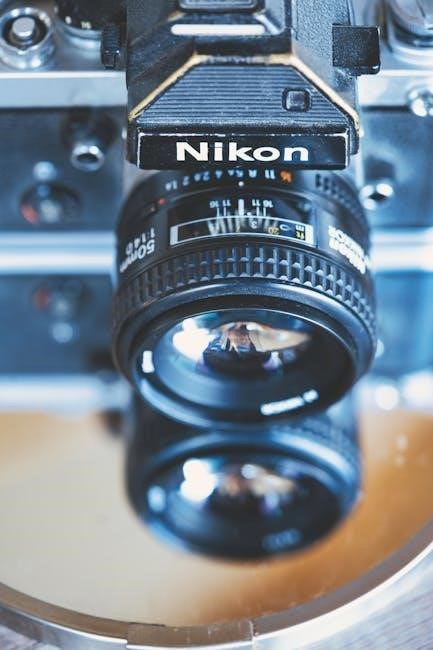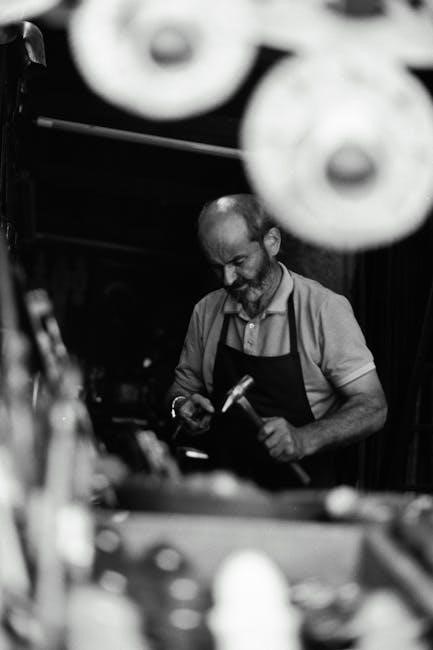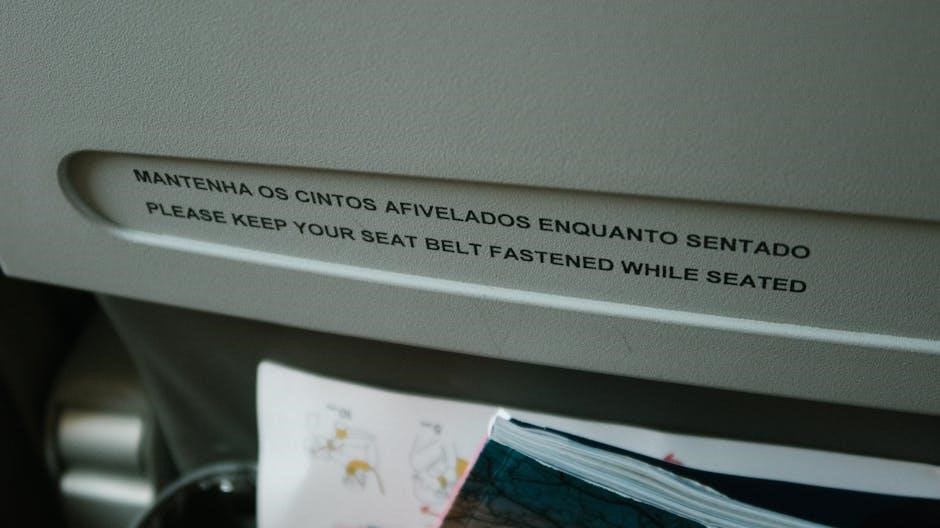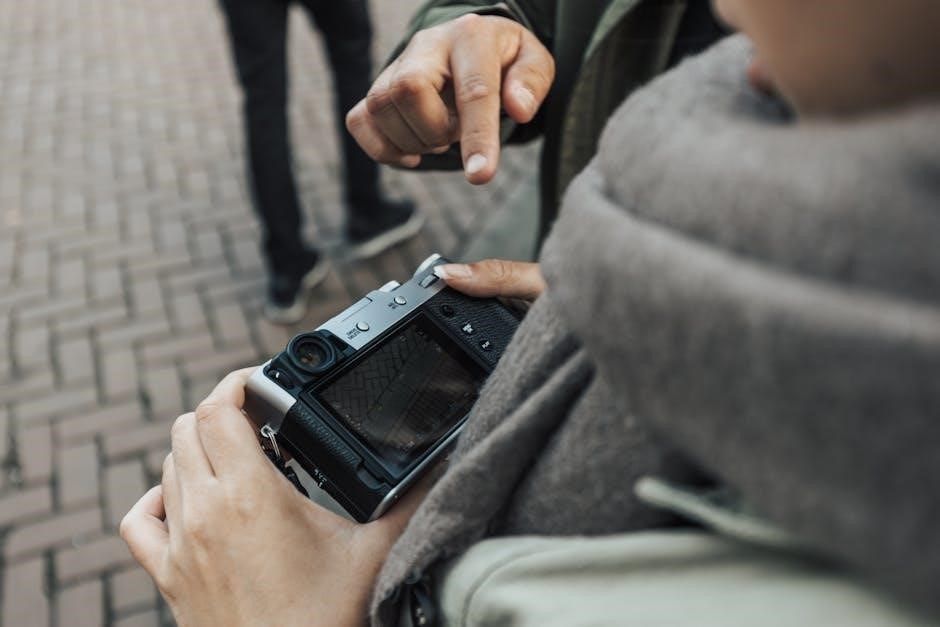The Nikon D7500 is a powerful DSLR camera designed for enthusiasts and professionals, offering exceptional image quality and advanced features. This guide provides a comprehensive overview of its operation, settings, and techniques to help users master their photography skills.
1.1 Overview of the Nikon D7500
The Nikon D7500 is a high-performance DSLR camera designed for photography enthusiasts and professionals. It features a 20.9-megapixel APS-C sensor, EXPEED 5 image processor, and a weather-sealed body for durability. The camera offers excellent image quality, fast autofocus, and 4K video recording capabilities. Its versatility makes it suitable for various photography genres, including action, portraits, and landscapes. With a robust build and advanced features, the D7500 is a reliable choice for capturing stunning images and videos in diverse conditions.
1.2 Key Features and Specifications
The Nikon D7500 boasts a 20.9-megapixel APS-C DX-format sensor and the EXPEED 5 image processor, delivering high-resolution images with excellent low-light performance. It features an ISO range of 100-51200, expandable to 50-1640000. The camera includes a 51-point autofocus system with 15 cross-type sensors for precise subject tracking. It supports continuous shooting at 8 fps and records 4K UHD video at 30p. The D7500 also offers built-in Wi-Fi and Bluetooth for seamless connectivity, along with a tilting 3.2-inch touchscreen LCD for intuitive control. These features make it a versatile tool for both stills and video capture.
1.3 Importance of the Instruction Manual
The instruction manual is essential for unlocking the full potential of the Nikon D7500. It provides detailed guidance on basic operations, advanced techniques, and troubleshooting, ensuring users understand all features and settings. The manual covers topics like image quality, autofocus, and custom settings, helping photographers optimize their workflow. It also includes solutions for common issues, enabling users to resolve problems quickly. By following the manual, photographers can enhance their skills, explore creative possibilities, and achieve the best results from their camera.
Basic Operation of the Nikon D7500
Mastering the Nikon D7500’s basic operation involves understanding power-on, mode selection, and fundamental shooting techniques. Familiarizing yourself with the camera’s layout and essential settings ensures smooth functionality.
2.1 Unpacking and Initial Setup
When unpacking your Nikon D7500, ensure all accessories are included, such as the battery, charger, and memory cards. Charge the battery fully before first use. Insert the memory cards into the camera, ensuring they are compatible and formatted. Power on the camera and navigate through the initial setup menu to set the language, date, time, and other preferences. Familiarize yourself with the camera’s layout and basic controls to prepare for shooting. Proper setup ensures optimal performance and a seamless photography experience.
2.2 Understanding the Camera Layout
Familiarizing yourself with the Nikon D7500’s layout is essential for efficient operation. The camera features a mode dial on the top right for selecting shooting modes, a shutter release button, and command dials for adjusting settings. On the back, the 3.2-inch LCD screen dominates, alongside the viewfinder for composing shots. Navigation buttons and the multi-selector enable menu navigation, while the lens release button and memory card slot are conveniently located. Understanding each component’s function ensures intuitive control and enhances your shooting experience.
2.3 Basic Shooting Techniques
Mastering basic shooting techniques with the Nikon D7500 enhances your photography experience. Start by holding the camera firmly, using the viewfinder for accurate composition. Focus on your subject using the AF modes, ensuring sharpness. Adjust exposure settings like aperture, shutter speed, and ISO for optimal results. Experiment with composition techniques such as the rule of thirds and leading lines. Review images on the LCD screen and use the histogram for exposure feedback. Practice these fundamentals to capture stunning photos consistently and refine your skills over time.
Shooting Modes
The Nikon D7500 offers various shooting modes, including Auto, Program, Aperture Priority, Shutter Priority, Manual, and Scene Modes, catering to different skill levels and photography needs effectively.
3.1 Auto Mode

Auto Mode on the Nikon D7500 is designed for beginners or casual shooters, automatically adjusting settings like exposure, autofocus, and ISO for optimal results. The camera analyzes the scene and selects the best parameters, allowing users to focus solely on composition. This mode is ideal for quick snapshots or situations where time is limited. It simplifies photography by handling complex settings internally, ensuring well-balanced images with minimal effort. Auto Mode is a great starting point for new users to familiarize themselves with the camera before exploring manual controls.
3.2 Program Mode (P)
Program Mode (P) on the Nikon D7500 offers a balance between simplicity and control. The camera automatically sets aperture and shutter speed for a balanced exposure, but users can adjust these settings using the Flexible Program feature. This mode is ideal for photographers who want to make minor adjustments without manually controlling both aperture and shutter speed. It provides flexibility while maintaining ease of use, making it a great intermediate step between Auto Mode and more advanced modes like Aperture Priority or Shutter Priority.

3.3 Aperture Priority Mode (A/Av)
Aperture Priority Mode (A/Av) on the Nikon D7500 allows users to set the aperture manually, while the camera automatically adjusts the shutter speed to achieve the correct exposure. This mode is ideal for controlling depth of field, making it perfect for portrait and landscape photography. By adjusting the aperture, users can create a shallow depth of field to isolate subjects or a wide depth of field to keep entire scenes sharp. The camera handles the rest, ensuring a well-balanced exposure while providing creative flexibility.
3.4 Shutter Priority Mode (S/Tv)
Shutter Priority Mode (S/Tv) on the Nikon D7500 lets users manually set the shutter speed, while the camera automatically adjusts the aperture for proper exposure. This mode is ideal for capturing motion, allowing control over freezing fast-moving subjects or creating artistic blur. By selecting a faster shutter speed, users can freeze action, while slower speeds create motion blur, adding dynamism to images. This mode is perfect for sports, wildlife, and creative photography, giving users precise control over time-based effects while the camera handles the rest of the exposure settings.
3.5 Manual Mode (M)
Manual Mode (M) on the Nikon D7500 offers full creative control, allowing users to independently adjust both aperture and shutter speed. This mode is ideal for experienced photographers who want precise control over exposure settings. By manually setting these parameters, users can achieve specific artistic effects, such as depth of field or motion blur. The camera provides an exposure meter to guide adjustments, ensuring optimal results. Manual Mode is perfect for those who understand exposure principles and want to customize their shots for unique visual outcomes, offering unparalleled flexibility in capturing images exactly as envisioned.
3.6 Scene Modes
Scene Modes on the Nikon D7500 allow users to capture specific types of photos with optimized settings. Common modes include Portrait, Landscape, Sports, Close-up, and Night Portrait. Each mode adjusts camera settings like aperture, shutter speed, and ISO to suit the scene. For example, Portrait mode emphasizes subject details, while Landscape mode prioritizes sharpness and color accuracy. These modes are ideal for beginners or those who want to achieve professional results without manual adjustments. Additional modes like Night Landscape and Super Vivid ensure versatility for various shooting scenarios, making it easier to capture stunning images in diverse conditions.

Shooting Menu
The Shooting Menu allows configuration of image settings like Image Quality, White Balance, Autofocus, and ISO Sensitivity to optimize camera performance for desired results.
4.1 Image Quality Settings
The Nikon D7500 offers customizable Image Quality Settings, allowing users to choose between RAW and JPEG formats. RAW captures maximum detail for post-processing, while JPEG provides compressed, ready-to-use files. Image Size options include Large, Medium, and Small, enabling adjustments based on storage needs and resolution requirements. White Balance settings ensure accurate color representation under various lighting conditions. These settings are essential for achieving desired image outcomes and optimizing workflow efficiency. Proper configuration enhances both creativity and technical quality in photography.
4.2 White Balance Options
The Nikon D7500 offers a range of White Balance options to ensure accurate color representation in various lighting conditions. Options include Auto, Incandescent, Fluorescent, Direct Sunlight, Flash, Cloudy, Shade, and Preset Manual. Auto White Balance automatically adjusts colors based on lighting, while specific presets like Incandescent and Fluorescent cater to artificial light sources. Direct Sunlight and Cloudy settings optimize colors for natural lighting, and Preset Manual allows for custom measurements. These options enable precise control over color tones, ensuring images reflect the true ambiance of the scene being captured.
4.3 Autofocus Settings
The Nikon D7500 features advanced autofocus settings to enhance precision and flexibility. Users can choose from Single AF, Continuous AF, and Manual Focus modes. AF-area modes include Single-point AF, Dynamic-area AF, 3D Tracking, and Auto-area AF, allowing customization based on the subject’s movement. Additional options like AF-C priority selection and focus tracking enable fine-tuned control. These settings ensure sharp focus in various shooting scenarios, from stationary subjects to fast-moving objects, making the D7500 versatile for diverse photography needs.
4.4 ISO Sensitivity
The Nikon D7500 offers a wide ISO sensitivity range of 100 to 51,200, extendable to 50 and up to 1,640,000. This allows shooting in various lighting conditions, from bright daylight to low-light environments. Auto ISO enables automatic adjustment based on lighting, while manual control provides flexibility. Users can set a maximum ISO and minimum shutter speed for Auto ISO, balancing noise reduction and image quality. These settings are accessible via the Shooting Menu, ensuring optimal performance in diverse photography scenarios while maintaining image clarity and detail.
Custom Settings
Custom settings on the Nikon D7500 allow users to personalize camera controls, shooting preferences, and display options for enhanced efficiency and comfort during photography sessions.
5.1 Custom Controls
The Nikon D7500 allows users to customize camera controls to suit their preferences, enhancing shooting efficiency. The Fn button, for instance, can be assigned to frequently used functions like ISO sensitivity or white balance. Additionally, the multi-selector and sub-command dial can be programmed for quick access to specific settings. This feature enables photographers to streamline their workflow, ensuring intuitive operation during shoots. By personalizing controls, users can focus more on creativity and less on menu navigation, making the camera an extension of their photographic vision.
5.2 Custom Shooting Settings
The Nikon D7500 offers customizable shooting settings, allowing photographers to tailor the camera to their preferences. Users can save personalized settings, such as autofocus modes, metering options, and bracketing configurations, ensuring quick access during shoots. These customizations can be stored in the camera’s memory, enabling consistent results across different sessions. By adjusting and saving these settings, photographers can streamline their workflow, reducing time spent on menu navigation and focusing more on capturing the perfect shot. This feature enhances efficiency and adaptability for various shooting scenarios.
5.3 Custom Display Settings
The Nikon D7500 allows users to customize display settings to suit their preferences. Photographers can adjust the LCD screen’s brightness, color balance, and grid display options for precise composition. Additionally, the camera offers customizable information display, enabling users to choose which shooting data appears on the screen. These settings enhance workflow efficiency and provide a personalized shooting experience. By tailoring the display to individual needs, photographers can focus more on capturing images and less on menu adjustments, ensuring a seamless and intuitive operation.

Image Playback and Editing
The Nikon D7500 offers robust playback and editing features, allowing users to review images, adjust settings, and perform basic edits directly on the camera. This enhances workflow and creativity.
6.1 Playback Options
The Nikon D7500 provides versatile playback options for reviewing images. Users can zoom in on details, delete unwanted photos, and view thumbnails for quick browsing. The camera also supports slideshow playback and image rotation. Additionally, the LCD screen allows for easy navigation and review of shooting data, histograms, and focus points. These features enable photographers to efficiently manage and assess their work directly on the camera, enhancing their workflow and creative process. The intuitive controls make it simple to organize and review images in the field or studio.
6.2 In-Camera Image Editing
The Nikon D7500 offers a range of in-camera image editing tools, allowing photographers to enhance their photos without a computer. Users can adjust RAW images, trim photos, and apply filter effects like monochrome or sepia. The camera also supports image overlay and resizing, making it easy to refine shots on the go. These editing features provide flexibility and convenience, enabling photographers to fine-tune their work directly on the camera before transferring or sharing their images.

Connectivity and Transfer
The Nikon D7500 supports USB, HDMI, Wi-Fi, and Bluetooth for seamless image transfer and remote shooting. These features enable easy sharing and control via the SnapBridge app.
7.1 USB and HDMI Connections
The Nikon D7500 features USB and HDMI ports for easy connectivity. The USB port allows for transferring images to a computer and charging the battery. The HDMI port enables high-definition video output to external devices like TVs or monitors. These connections support efficient workflow and sharing of content. The USB connection is compatible with standard USB cables, while the HDMI connection supports high-resolution output for previewing images and videos. These features enhance the camera’s versatility for both professional and casual use, ensuring seamless integration with external devices.

7.2 Wi-Fi and Bluetooth Connectivity
The Nikon D7500 supports Wi-Fi and Bluetooth connectivity, enabling wireless communication with compatible devices. Wi-Fi allows for high-speed image transfer to smartphones, tablets, or computers, while Bluetooth provides a low-power connection for seamless pairing and remote camera control via the SnapBridge app. These features enhance convenience, enabling easy sharing of photos and remote shooting capabilities. The camera can also automatically transfer images to a smartphone or tablet, making it ideal for instant sharing and backup; This wireless connectivity simplifies workflow and expands creative possibilities for photographers on the go.
7.3 Transferring Images to a Computer
Transferring images from the Nikon D7500 to a computer can be done via USB, HDMI, or wirelessly using Wi-Fi. Connect the camera directly to your computer using the provided USB cable, or transfer images wirelessly through the SnapBridge app. The camera also supports tethered shooting, allowing real-time transfer of photos to your computer. Additionally, you can use Nikon’s software tools to import, organize, and edit images efficiently. This feature ensures seamless workflow and easy backup of your captured moments, making it convenient for photographers to manage their files.
7.4 Remote Shooting with SnapBridge
Remote shooting with SnapBridge allows users to control the Nikon D7500 from a smartphone or tablet. The app enables live view, shutter release, and adjustments to settings like exposure and focus. It also supports wireless image transfer and remote monitoring. SnapBridge is compatible with iOS and Android devices, providing a convenient way to capture photos without physical access to the camera. This feature is ideal for wildlife, studio, or group photography, offering enhanced creativity and control. It ensures seamless connectivity and efficient workflow for photographers of all levels.
Advanced Techniques
The Nikon D7500 supports advanced techniques like shooting in RAW format, bracketing, HDR, and time-lapse photography, enhancing creativity and image quality for capturing professional results.
8.1 Shooting in RAW Format
Shooting in RAW format on the Nikon D7500 captures uncompressed image data, preserving maximum detail for post-processing. This format is ideal for advanced photographers, offering greater flexibility in editing exposure, color, and noise reduction. RAW files are larger than JPEGs but provide superior quality. To enable RAW, navigate to the Shooting Menu, select Image Quality, and choose RAW or RAW + Fine. Note that RAW files require specialized software for editing, such as Adobe Lightroom or Nikon’s Capture NX-D, to unlock their full potential for professional-grade results.
8.2 Bracketing and HDR

Bracketing on the Nikon D7500 allows capturing multiple shots at different exposures to merge into a single image with enhanced dynamic range. This is ideal for high-contrast scenes. To enable bracketing, go to the Shooting Menu, select Bracketing, and choose the number of shots (up to 9) and exposure intervals. For HDR, enable HDR (High Dynamic Range) in the Shooting Menu, and the camera will automatically merge the bracketed images into one. This feature ensures detailed shadows and highlights, producing vibrant and realistic results in challenging lighting conditions.

8.3 Time-Lapse Photography
Time-lapse photography captures a sequence of images at set intervals to create a condensed video of events like sunsets or traffic. On the Nikon D7500, enable Interval Timer Shooting via the Shooting Menu. Set the interval, number of shots, and start time. Use a tripod for stability. The camera will automatically capture the sequence, which can later be converted into a time-lapse video using Nikon’s software. This feature is ideal for showcasing dynamic changes in a scene, offering a creative way to tell stories through compressed time.
Maintenance and Troubleshooting
Regularly clean the camera and lens to prevent damage. Update firmware for optimal performance. Troubleshoot common issues like error messages or connectivity problems using the manual’s guidance.
9.1 Cleaning the Camera and Lens
Regular cleaning is essential to maintain the Nikon D7500’s performance. Use a soft, dry cloth to wipe the camera body and lens exterior. For the sensor, use a blower to remove dust. Avoid touching the lens surface; instead, use a microfiber cloth with a few drops of lens cleaning solution. Never use harsh chemicals or tissues, as they may damage coatings. Refer to the manual for detailed cleaning procedures to ensure optimal image quality and prevent damage to your equipment.
9.2 Updating Firmware
Updating the Nikon D7500’s firmware ensures optimal performance and security. Check the current firmware version in the camera menu and compare it with Nikon’s official website. Download the latest firmware to a memory card using a card reader or the camera’s USB connection. Format the memory card in the camera before copying the firmware file. Insert the card, navigate to the firmware update option in the menu, and follow on-screen instructions. Avoid interrupting the update process to prevent damage. Refer to the manual for detailed steps to ensure a successful update.
9.3 Common Issues and Solutions
Common issues with the Nikon D7500 include error messages, autofocus malfunctions, and memory card errors. For error messages, refer to the manual or Nikon’s support site for troubleshooting. Autofocus issues may require cleaning the sensor or adjusting settings. Memory card errors can often be resolved by formatting the card in the camera. If problems persist, resetting the camera to default settings or updating firmware may help. Always ensure the camera and lenses are clean and free of debris to maintain optimal performance and avoid common issues.
The Nikon D7500 manual provides essential guidance for mastering the camera. For further learning, explore Nikon’s official website, user forums, and tutorial videos to enhance your photography skills.
10.1 Summary of Key Points
The Nikon D7500 manual is a comprehensive guide for mastering the camera’s features, from basic setup to advanced techniques. It covers essential topics like shooting modes, custom settings, and image playback. The manual emphasizes understanding key functions such as autofocus, ISO sensitivity, and white balance for optimal results. Additionally, it provides troubleshooting tips and maintenance advice to ensure the camera’s longevity. By following the manual, users can unlock the D7500’s full potential and improve their photography skills. Further resources, like online tutorials and Nikon’s support website, are recommended for continued learning.

10.2 Additional Resources for Learning
For deeper understanding, Nikon offers the Manual Viewer 2 app for offline access to the D7500 manual. Online resources like Nikon’s official website and platforms such as ManualOwl provide downloadable PDFs and tutorials. Video guides on YouTube and forums like Nikon Users Group offer practical insights. Books and courses on platforms like Udemy and Coursera cover advanced techniques. Nikon’s customer support and community forums are excellent for troubleshooting and tips. These resources complement the manual, ensuring users maximize their D7500’s capabilities and enhance their photography skills effectively.

